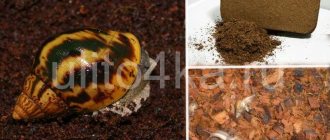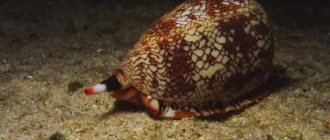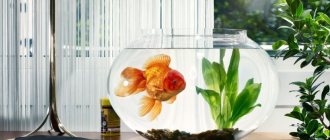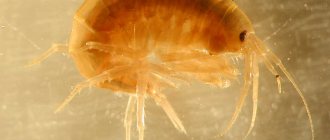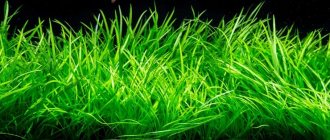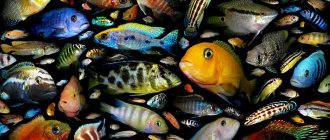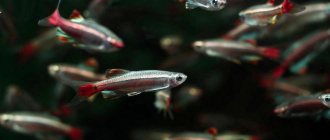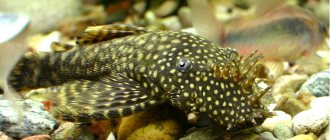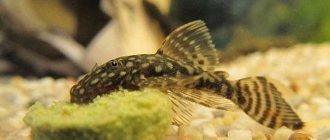And don't look like that!
Holy... Previously, the Black Mystery (apple snail) was called Pilidae. In pet stores they are sold small - usually one and a half centimeters in length - but over time the snails grow up to five centimeters. In the wild, the snail lives in Brazilian reservoirs: it is active at night and rests during the day. In the process of searching for “something to eat,” this mollusk can even get out onto land.
How to keep snails: main features
The main feature of snails is their slowness. They live in various bodies of water in different countries of the world.
Snails can appear spontaneously in your aquarium, so it is not always necessary to introduce them. When purchasing algae for your aquarium, you can easily bring them into your apartment with you. But it’s one thing if these are beautiful large snails, and another thing if these are ordinary coils that are of no particular use. Moreover, they multiply uncontrollably, which can disrupt the biobalance of the closed aquarium ecosystem. Some types of snails can pose a danger to fry and even shrimp.
Keeping and caring for snails, first of all, involves maintaining the correct water characteristics. They are very picky about the condition of the water - if it is soft or acidic, then they will not have enough minerals necessary for the construction of the shell. Accordingly, the water for their habitat must be sufficiently hard and saturated with calcium.
Snails can withstand different temperatures - from 18 to 28 degrees Celsius. We recommend purchasing them from a specialized pet store.
An important point is the choice of soil, which should be fine or coarse sand (soil 1-2 mm in size is suitable). For normal living, snails, like aquarium fish, require 10 liters per individual.
Neritina
This species of small snail lives in brackish or fresh water and belongs to the order Cycloneritimorpha.
Appearance
Neretina is a very interesting species of gastropod with a teardrop-shaped shell. The shell almost completely covers the mollusk. The main feature of the yellowish-brown shell is the presence of longitudinal stripes and dots. Therefore, the mollusk is a bit like the Colorado potato beetle.
Lifestyle
Life expectancy is not very long - only 1-2 years. Some of the neretins die in the first week after being moved to the aquarium, as they tolerate transportation and new living conditions very poorly.
Lives in algae, which are also food. It feeds on rotting parts of plants and soft algae. Neretina is a bisexual mollusk, but eggs laid in a freshwater artificial reservoir are not viable.
It is indifferent to the other inhabitants of the aquarium, but due to its soft shell it can easily be harmed by fish that feed on shellfish.
Content requirements
Being a tropical species, it can live in water with a temperature not lower than +25 C. It can reproduce only in salt water. Water should be of medium hardness with an acidity of 7 Ph.
What to feed aquarium snails?
The diet of aquarium snails does not include healthy plants (with the exception of invasive species). Therefore, the opinion that their vital activity negatively affects the aquarium ecosystem is not entirely correct.
Gastropods are herbivorous mollusks (with the exception of Helena). They feed on detritus - this is dead organic matter (for example, rotting pieces of greenery or excess food). In the absence of food, they can feed on leftover fish food.
Their main diet is microalgae and higher plants. They can also be fed raw vegetables, which must first be soaked in hot water for a few minutes (lettuce, cabbage, carrots).
Reels
Decorative snails that can become a decoration for an aquarium, provided that there are not many individuals in it. Their main function is sanitary; they quite actively eat dead parts of algae and food residues, and prevent water pollution.
A significant disadvantage is the high reproduction rate. If the population is not controlled, the reels will fill the bottom in a short time. There is one caveat: mollusks of this genus multiply quickly when they receive food in excess, so their rapid reproduction is a signal that you are overfeeding the fish.
@ yurok.a — depositphotos.com
Snails are not the most effective aquarium cleaners. Find out which creatures are better at keeping things clean than they are.
Before buying snails for your aquarium, you should carefully study the information about their content. Many varieties are very difficult to get rid of later, and the benefits from them are less than the harm. If you choose the right snail, it will help make the aquarium more beautiful, promote natural processes and help establish balance.
Snail breeding
Snails reproduce in different ways, depending on their species - dioecious or hermaphrodite. In the first case, everything happens naturally, so in most cases they are immediately bought in bunches.
The second type of snail can degenerate if the balance of the sexes in the aquarium is disturbed. In this case, one individual is enough to wait for offspring. But in most cases, this applies to those species of snails that are considered invasive.
Reproduction methods are also different. Some individuals lay eggs in water, attaching them to plants or rocks. Other snails develop offspring in their own body.
Their eggs are so small that it is not always possible to see them with the naked eye. These mollusks reproduce quite intensively, so it is not uncommon for snails to become the predominant species in the aquarium.
If there is too much snails in the aquarium, this will lead to the following consequences:
- Water pollution. Snails clean the water, but they themselves can pollute it. If there are too many of them, the urea they contain will have an adverse effect on them, which may result in their death.
- Emergency situations. These include, for example, filter failure. A snail in search of food may simply wander into the wrong place, thereby clogging the filter system.
Melania
Melanias are ground snails, the size of which rarely exceeds 2 cm. Individuals breathe through gills, and therefore can remain in the ground for a long time without rising to the surface. The snails are dioecious, inconspicuous, and viviparous. They do not perform any aesthetic function and are practically invisible.
@ Wirestock - depositphotos.com
Melanias can be markers of water quality. If there is not enough oxygen in it or it is polluted, individuals actively crawl out of the aquarium and can be observed on the walls.
Main types of aquarium snails
There are a large number of different types of aquarium snails. We list only the main ones.
Ampularia
The ampularia comes from South America, its shell reaches 12 cm. There are different color options: brown, yellow, etc. Individuals see poorly, they have no ears, i.e. they are completely deaf.
For its normal functioning, it is necessary to maintain certain water parameters: temperature - from 20 to 25 degrees Celsius, acidity level - up to 7.8 pH. The volume of the aquarium must be at least ten liters.
For their reproduction, certain conditions must be created. In particular, it is necessary to add sufficient food and raise the temperature slightly. Their average life expectancy is no more than 5 years.
Coil
Belongs to the category of hermaphrodites. They have red blood, so their color is directly affected by their hemoglobin levels.
Comfortable living temperature is from 22 to 28 degrees Celsius. The average lifespan in an aquarium is 2-3 years. In natural habitats – 4 years.
Melania
This type of snail is now common in different countries of the world, regardless of the type of climate: temperate climate zone, tropics or subtropics.
They reach a length of 3 cm. The most common color options are olive and brown.
These aquarium snails clean the bottom while searching for food. During the day, as a rule, they hide in thickets of plants, and appear only after dusk.
The main diet is detritus, droppings of aquarium fish, as well as the remains of the food they feed on. They reproduce quite quickly, so over time they can become a problem for the aquarium. In captivity they live up to three years (at an optimal temperature of 22 to 28 degrees Celsius).
Neretina
There are several varieties of these snails, which differ from each other in appearance and color. The largest of them are zebra and tiger, which can reach a length of 3.5 cm.
Effectively cleans the walls of aquariums from dirt. You can feed them spirulina, as well as varnish flakes. They are active at any time of the day.
Helena
Helenas grow up to 2 cm in length. They are not suitable for keeping in an aquarium because they eat their relatives (unless you use them as predators when you need to get rid of a large number of snails).
Comfortable temperature is from 23 to 27 degrees Celsius. In this case, individuals will not be able to reproduce at a relatively low temperature (20 degrees).
Hercules
It has quite impressive dimensions, which is why it got its name. Peaceful towards other aquarium inhabitants.
The main diet is microalgae. If you provide them with sufficient nutrition, they will not encroach on higher plants.
Tylomelania
They are distinguished by the diversity of species, which is determined by their natural habitat. Basically, it is water (flowing or standing) and soil type.
Individuals can reach a length of 10 cm or more. They reproduce quite intensively. The main diet is:
- detritus;
- spirulina;
- shrimp food;
- green vegetables;
- live food
Marisa
These are gastropods that usually have a striped body color. Natural habitat - water bodies of South America.
For their normal maintenance, it is important to maintain a sufficiently high temperature level. Another requirement is an aquarium with a volume of at least 20 liters with good aeration and a filtration system. In addition, you need to provide them with access to the surface of the water so that they can breathe.
Horned
The name is telling because the shell of this snail has spines that serve as protection from predators. They have a fairly bright color, so they look good in home aquariums.
Snails are small in size, so they crawl even into the most remote places. They benefit the closed aquarium ecosystem by destroying algae without harming the plants.
Contained in tanks with a volume of 10 liters or more. They are quite peaceful creatures, so they get along well with aquarium fish with a calm temperament. In addition to algae, they feed on fish food and vegetables.
Black mystery
It is able to breathe air through a special appendage, so it often crawls to the surface of the water.
The color is black, as is clear from the name. Gets along well with other aquarium inhabitants and does not harm the plant. Moreover, black mysteria performs an important function - it helps clean the aquarium by eating algae deposits on the walls.
Devil's thorn
The rather intimidating name does not affect their character - they get along well with shrimp and calm species of aquarium fish. A characteristic feature is a long, pointed shell of a rich black color.
The length is about 8 cm. The aquarium should have a volume of 10 liters or more. It is quite difficult to create conditions for their reproduction, because this requires very salty water. They feed on vegetables, fish food, and plaque on the walls of the aquarium.
This is not a complete list of snails that can be bred in an aquarium, but we have noted the main ones that have a fairly attractive color and can, to one degree or another, get along with other aquarium inhabitants.
But cases often arise when the number of snails in an aquarium turns out to be very large and they begin to threaten the aquarium ecosystem. Here there is already a need to reduce their numbers, so it is important to know what methods are suitable for this.
Helena
A popular freshwater snail from the family Nassariidae in Southeast Asia.
Appearance
Helena is an original snail with a conical shell. Along its girth there are yellow and dark circles. The size of the mollusk is about 2 cm.
Lifestyle
The lifespan of this tropical mollusk is about 3-4 years. Young Helenas live at the bottom of the aquarium for 6 months, so they need loose sandy or gravel soil. Adults do not have any particular habitat preferences.
Plants such as coryfolia, Pogostemon Helfera, Pogostemon erectus, Lomariopsis, Hemianthus Cuba, Echinodorus, Pogostemon octopus, Sagittaria, Marsilia, Java moss, Aquascape, Cryptocoryne and Hornwort in the aquarium play an important role in the life of its inhabitants.
To avoid diseases, you must:
Helena is a predator that feeds on other mollusks, eggs of snails and fish. It is an excellent way to reduce the population of other snails naturally.
Reproduction in Helena is bisexual. The eggs are laid on solid objects in the aquarium. After 2 weeks, the hatched helenas fall to the bottom of the aquarium and burrow into the ground, where they grow until puberty. The survival rate of young individuals is not very high, which is associated with the struggle for food in the bottom layer during development and growth.
Important! Predatory shellfish are accused of killing fish. This is not true: a snail simply cannot catch up with an active and fast fish. But since many snails happily eat carrion, it is possible that it ate an already dead fish. Remove dead fish and shellfish from the aquarium in a timely manner: this will keep the ecosystem healthy.
Content requirements
The snail is very hardy and not too demanding to care for. Can live in slightly acidified water. Helenas live and develop comfortably in water of medium hardness and tolerate light salinity of water. Like other tropical species, it needs water with a temperature of at least +20 C.
The substrate in the aquarium should be sand or very fine gravel.
Basics of care and feeding
Helena will do an excellent job of reducing the number of other aquarium snails. It can eat eggs of both snails and fish. If there are no shellfish in the ecosystem, Helena can be fed with fresh frozen shrimp meat or krill about 3 times a day.
There are a huge variety of aquarium mollusks in the world that can live in similar environments. Each of these types has its own characteristics. Armed with this knowledge, you can easily make a choice in favor of exactly those inhabitants that are necessary for the ecosystem of your aquarium.
